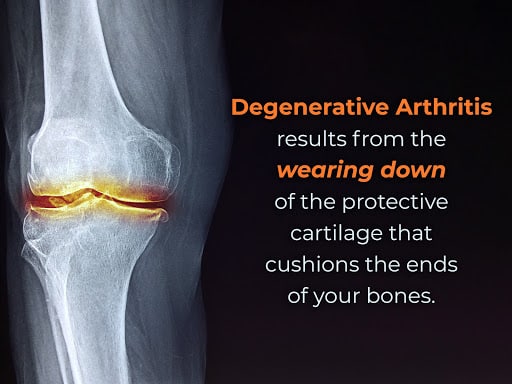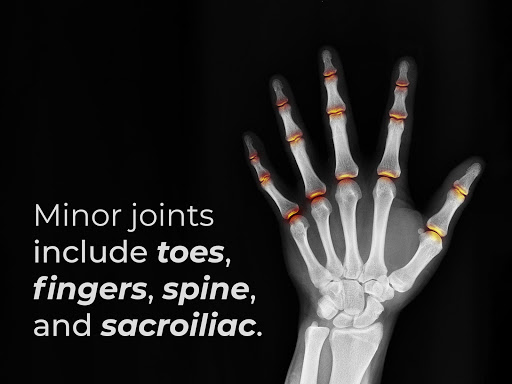Arthritis is the most common disability and affects 52.5 million adults in the United States, or one in every five. There are two main types of arthritis: degenerative arthritis and rheumatoid arthritis. For the purposes of this blog, the primary focus will be on VA disability for degenerative arthritis, which affects 27 million Americans.
Degenerative arthritis may also be referred to as osteoarthritis and is the most common form of arthritis. According to the American Academy of Orthopedic Surgeons, degenerative arthritis is the primary reason for discharge from active duty military service. Degenerative arthritis of the spine is listed as one of the most prevalent service-connected medical conditions in the 2018 VA benefits report, with 505,553 disability benefits recipients for the condition. The report then lists general degenerative arthritis and traumatic arthritis with 268,882 and 258,135 recipients, respectively.
In contrast to rheumatoid arthritis – a chronic, inflammatory, autoimmune disorder that can affect more than your joints – degenerative arthritis results from the wearing down of the protective cartilage that cushions the ends of your bones. Degenerative arthritis leads to symptoms including pain, stiffness, limitation of motion, limitation of flexion, grating sensation or clicking with joint use (known as crepitus or crepitation), swelling, and joint instability or buckling (i.e., knee giving out). Osteoarthritis can theoretically affect any joint but typically occurs in your hands, feet, spine and hips. While it is known to result in the breakdown of cartilage, it also affects the entire joint.

As the condition worsens, the bone may harden, change shape or develop bone spurs. Additionally, the connective tissues deteriorate and there is often inflammation of the joint lining. Some of the causes include joint injuries or repeated stress on the joint(s) from sports or job duties. For the average person, the cartilage breaks down gradually but for veterans, the breakdown often occurs suddenly within one or two years post injury. In some cases, these conditions may lead to loss of use and incapacitating episodes. This functional loss could require surgery such as a knee replacement.
How to Prove Service Connection For Arthritis
As with all VA disability claims, proving service connection is the first important step. Because of the nature of the condition, there doesn’t need to be a traumatic event, or injury, to prove service connection for osteoarthritis. Repetitive stress on your joints with documented symptoms can be sufficient to establish your claim since service connection for arthritis may be proven through continued symptomology. This means that the typical medical evidence of a diagnosis or nexus is not necessarily needed if you are able to show continuation of reported symptoms from service.
To establish service connection through continuity of symptomatology, the claimed disability must be considered chronic pursuant to 38 CFR 3.309(a), symptoms must be documented in service and after discharge, and there must be a connection between your post-service symptoms and your current disability.
But arthritis can also be presumptively service-connected. According to the VA regulations, if your symptoms of arthritis appear within one year of discharge from service and qualify for at least a 10% VA disability rating, the presumption of service connection applies.
Another option for service connection is to claim arthritis as a secondary disability. In this scenario, your arthritis would have to be the result of, or secondary to, a separate disability that is currently service-connected. For example, the VA regulations provide that if you are service-connected for an amputation and subsequently develop arthritis, arthritis may be granted service connection secondary to the amputation.
VA Disability Ratings for Arthritis
Under the schedule of ratings in the VA regulations, arthritis may be rated under degenerative arthritis or rheumatoid arthritis. Several rating criteria affect the total rating decision. However, both are still rated under the musculoskeletal system conditions. Rheumatoid arthritis, as an active condition, may receive a 100% VA disability rating if you experience constitutional manifestations associated with active joint involvement and is totally incapacitating. The rating schedule then steps down to 60% disability rating which could still qualify a veteran to 100% disability compensation through total disability based on individual unemployability. Next possible rating for arthritis is 40%, followed by a 20% rating, which involves one or two exacerbations annually with a well-established diagnosis. Rheumatoid arthritis, in terms of chronic residuals, will be rated under the appropriate diagnostic code for the group of minor joints involved, major joints, etc. But, rheumatoid arthritis will only be rated either as an active condition or for its chronic residuals. The VA diagnostic code for rheumatoid arthritis is 5002.

Osteoarthritis can manifest from mildly disabling to almost complete impairment, and will be rated by the VA accordingly once service connection is proven. The VA may schedule a compensation and pension (C&P) examination to evaluate your arthritis and assign the appropriate rating. As with all VA disability ratings, the examiner will review your medical evidence looking for past diagnoses and symptoms. If there is insufficient documentation, the C&P examiner may order additional tests.
With any form of arthritis, your ranges of motion, and any associated pain, are important factors to be evaluated. Because limited motion is so vital to your arthritis rating, it is essential that physicians record the exact measurements for your range of motion measurements. For the most accurate measurement and associated rating, examiners often use a goniometer regarding your joint’s flexion and extension. Except for traumatic arthritis, the VA regulations state it is essential for your exam to cover all major joints.

The key is that the VA will initially look at each joint independently to decide whether there is limited motion and if there is joint pain with motion. If there is limited motion in your joint, then your condition will be rated based on that joint’s limited motion. If limited motion is not present, then you will receive one overall combined rating under VA diagnostic code 5003 for degenerative arthritis. Any claimed joint conditions will be rated as degenerative arthritis if there is not a significant measurement of limited range of motion to rate under those applicable diagnostic codes. The VA does not rate a disability under limited range of motion and degenerative arthritis.
Moreover, if there is pain (without limited motion), then the VA’s painful motion principle kicks in. Under the painful motion rule, the minimum compensable rating of 10% must be assigned. Therefore, the C&P examiner ought to test for active and passive, weightbearing and non-weightbearing, motion pain. If possible, the examiner should also test your unaffected joint for an accurate evaluation of your range of motion. Based on the painful motion regulation, you can theoretically receive a 10% rating for different joints as long as there is not overlap causing it to count twice. Although range of motion is a big factor, the functional impairment ought to be addressed as well. Factors including frequency and severity of joint swelling, stiffness, tenderness should all be reported and discussed to achieve a full picture of the severity.
Under the VA rating schedule, there is a standard 20% disability rating if there is x-ray evidence of involvement of two or more major joints, or minor joint groups, with occasional incapacitating exacerbations. Major joints include the shoulder, wrist, elbow, hip, knee, and ankle while minor joints include toes, fingers, spine, and sacroiliac. If two or more major or minor joint groups are affected, but there are no incapacitating exacerbations, a 10% rating may be assigned. If only one major or minor joint group is affected, you may only receive a rating higher than 0% under diagnostic code 5003 if there is also evidence of painful motion.
Additionally, while there are other forms of arthritis under the VA codes, such as pneumococcic or traumatic, these specific forms are rated within one of the two main umbrellas: degenerative or rheumatoid. If a condition is rated under degenerative arthritis, then your final rating may have a code listed prior to identify the condition itself and then list 5003 to show how it is rated (i.e., 5010-5003).
Temporary 100% Ratings For VA Disability Claims

Surgery can sometimes improve the function of the affected joints. Some veterans will undergo a knee replacement, with hip and knee joints being the most common, to help with mobility and pain. These surgical procedures for your arthritis may open the door to other claims, higher ratings, and VA disability benefits.
One of these includes a temporary rating based on hospitalization. If you are already service-connected for arthritis and stay in a hospital for over 21 days as a result of your condition (i.e., joint replacement surgery), you may qualify for a temporary 100% total rating for the duration of your hospital admittance. Similarly, the VA may award a temporary 100% disability rating for convalescence. This involves the recovery period following a surgery related to your service-connected condition. For a convalescence claim to be awarded, the period must be at least one month, surgery has resulted in postoperative residuals like being housebound or a continuing need for crutches or wheelchair, or a major joint has been immobilized by a cast.
If you need help with a service-connected claim for arthritis, feel free to give us a call for a free case evaluation!




